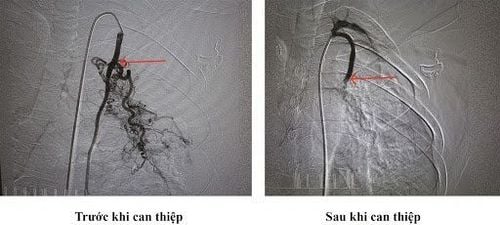This is an automatically translated article.
The article is professionally consulted by Master, Doctor Nguyen Thanh Nam - Radiologist - Department of Diagnostic Imaging - Vinmec Danang International General Hospital. The doctor has over 10 years of experience in the fields of Diagnostic Imaging.The technique of hemostasis embolization for the treatment of visceral trauma is a minimally invasive, highly effective, fast implementation time technique that reduces the risk of blood loss and saves the patient's life in a timely manner without having to undergo surgery. art.
1. What is visceral trauma?
Visceral trauma is damage to an organ with various forms such as tearing, contusion, or rupture of the organ; Lesions may be localized to one area of the body or be accompanied by other severe and multiple traumas. Injuries are classified based on organ structure such as:Solid organs: Liver, kidney, pancreas,... Hollow organs: Heart, stomach, uterus, bladder,... When visceral injury, disease Patients will be at risk of blood loss and lead to serious complications such as coagulopathy, dysfunction of the body's vital organs, multi-organ failure, hypovolemic shock and even death. In some cases, patients will be indicated for emergency surgery. However, the method of hemostatic embolization is one of the effective, less invasive methods and has now been widely applied in hospitals with interventional radiology units.

2. Technique of hemostasis embolization
The hemostatic embolization technique is used in the treatment of visceral bleeding without surgery. If done successfully, it will help stop bleeding immediately and preserve internal organs, helping the patient avoid major surgery. The technique of embolization is applied to vascular diseases caused by trauma to internal organs such as liver, spleen, and kidney. It also applies to non-traumatic vascular pathology such as pseudoaneurysm/aneurysm, gastric dilatation of the esophagus, uterine fibroids, prostate tumor, postpartum bleeding, hemoptysis in arterial dilation. bronchial, uncontrollable nosebleed, preoperative embolization, ...This method is performed by percutaneous angiography to identify damaged blood vessels (rupture, tear, perforation); then plug the lesion to stop bleeding with embolization materials such as PVA beads, embozene beads, ... or metal coils (coils). The placement of the interventional device is extremely small, does not cause bleeding and especially does not leave scars. In particular, the process of performing the technique only takes about 30-45 minutes and is painless, after 24 hours of embolization, the patient can be discharged from the hospital.
Acceptable indications for vascular embolization include:
Pseudoaneurysm; Arteriovenous catheterization; Solid organ damage; Pelvic fracture with bleeding. However, embolization is not recommended in unstable patients, and embolization should not be prolonged in patients requiring continuous transfusion.

3. Some complications can be encountered when embolization stops bleeding
In addition to the advantages that the hemostatic embolization method brings, besides the disadvantages of this method in the treatment of internal injuries include:Risk of infection: During the procedure, there may be risks of infection. inadvertently increase the risk of infection, possibly even causing blood infection; Arterial damage: Clotting the artery for too long will cause damage to the artery because there is no perfusion of blood there; Bleeding at the needle puncture site; The body reacts to the embolization material (very rare): When a foreign body is introduced into the body, depending on the physical condition of each person, there will be different reactions. Some people can cause an allergic reaction to the plug material. At Vinmec International General Hospital, diagnostic imaging plays an extremely important role when implementing hemostatic embolization techniques in visceral injury or non-traumatic vascular disease. Under the guidance of ultrasound machine, MRI machine, CT computerized tomography machine, modern DSA angiography room, the injury site will be identified and approached in many different directions. From here, doctors can quickly stop bleeding for the patient. Not only has a system of modern equipment, Vinmec is also a place to gather a team of experienced doctors and nurses who will greatly assist in the diagnosis and early detection of abnormal signs of the patient's body. . In particular, with a space designed according to 5-star hotel standards, Vinmec ensures to bring the patient the most comfort, friendliness and peace of mind.
Please dial HOTLINE for more information or register for an appointment HERE. Download MyVinmec app to make appointments faster and to manage your bookings easily.














